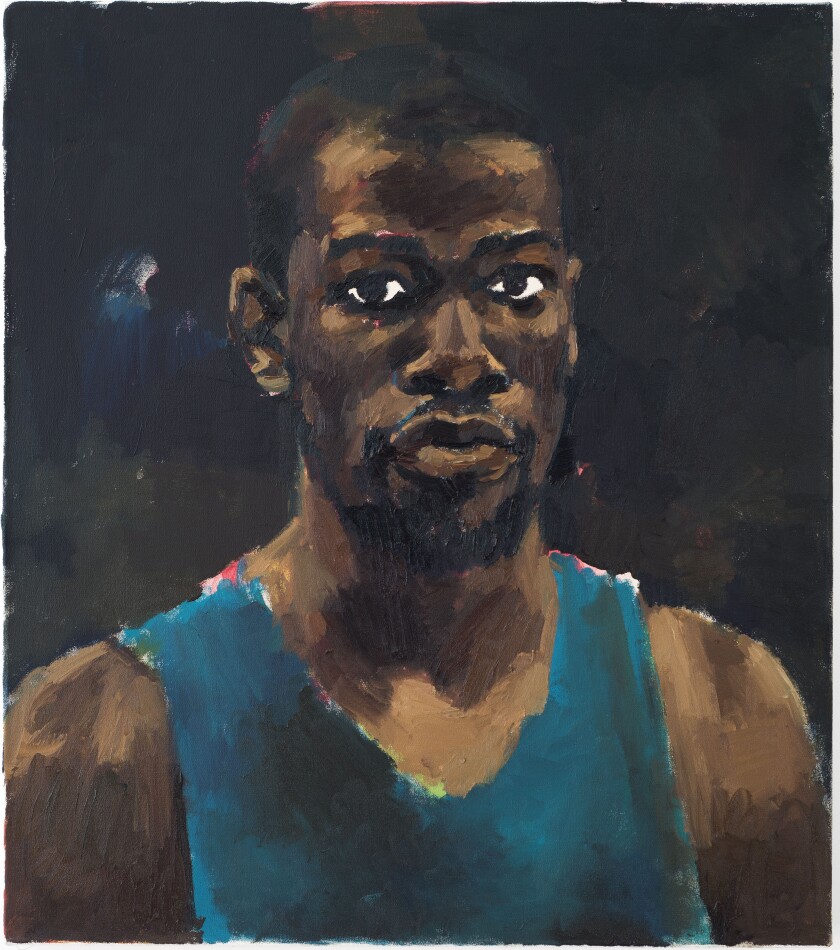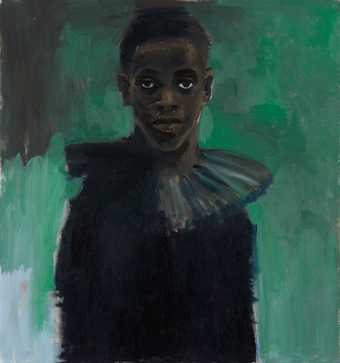Lynette Yiadom-Boakye is a British painter and writer. She is best known for her portraits of imaginary subjects, or ones derived from found objects, who are painted in muted colours. Her work has contributed to the renaissance in painting the Black figure. Her paintings often are presented in solo exhibitions.
1977
London, England
Ghanaian
Lynette Yiadom-Boakye was born in London in 1977. Her parents worked as nurses for the National Health Service after emigrating from Ghana. Yiadom-Boakye attended Central St Martins College of Art and Design. She did not enjoy her time there and so, moved to Falmouth College of Art in Cornwall, where she was awarded her undergraduate degree in 2000. She then completed an MA degree at the Royal Academy Schools in 2003.
She initially learned to paint by working from life, but changed her approach to painting at an early stage, while studying at Falmouth School of Art. Yiadom-Boakye realised she was less interested in making portraits of people and more in the act of painting itself.
Yiadom-Boakye works with oil paint on canvas or coarse linen. Ideas for her paintings are prompted by a variety of observations – a colour, a composition, a gesture or particular direction of the light. She uses found images, memories, literature and the history of painting as sources for her work. Each painting is an exploration of a different mood, movement and pose, worked out on the surface of the canvas.
In 2010, her work was recognised by the curator Okwui Enwezor, who gave her an exhibition at Studio Museum in Harlem. She was among those nominated for a prestigious prize in 2013. In addition to her artwork Yiadom-Boakye has taught at the Ruskin School of Art, Oxford University, where she is a visiting tutor for their Master in Fine Arts programme. Her influence as a painter was recognised in the 2019 Powerlist and she was subsequently listed among the Top 10 of the most influential people of African or African Caribbean heritage in the UK in 2020.
Yiadom-Boakye’s work consists mostly of painted portraits of imaginary Black subjects. Her paintings are predominantly figurative, with raw and muted colours. The characteristic dark palette of her work is known for creating a feeling of stillness that contributes to the timeless nature of her subjects. Her portraits of imaginary individuals feature people reading, lounging, and resting in traditional poses. She brings to the depiction of her subjects contemplative facial expressions and relaxed gestures, making their posture and mood relatable to many viewers. Commentators have attributed some of the acclaim of Yiadom-Boakye’s work to this relatability. She strives to keep her subjects from being associated with a particular decade or time. This results in choices such as not painting shoes on her subjects, as footwear often serves as a time stamp. These figures usually rest in front of ambiguous backgrounds, floating inside monochromatic dark hues. The cryptic butemotional backdrops remind commentators of `old master’ painters such as Velasquez and Degas.
Lynette Yiadom-Boakye’s style shifted slightly after the opening of her 2017 show In Lieu of a Louder Love,which featured a new, warmer colour scheme. Her subjects in this show included more vibrant details such as a chequered linoleumfloor, a bold headwrap and bathing suit, and a yellow, orange and green background.
Although generally each portrait contains only one person, the paintings typically are presented in groups that are arranged as if family portraits. With her expressive representations of the human figure, Yiadom-Boakye examines the formal mechanisms of the medium of painting and reveals political and psychological dimensions in her works, focussing on imaginary characters who exist beyond our world in a different time and in an unknown location. She paints figures who are intentionally removed from time and place, and has stated “People ask me, ‘Who are they, where are they?’ What they should be asking is ‘what’ are they?”
The Tate Museum provides an extensive introduction to her work which accompanied a major exhibition which was held from 2 December 2020 to 9 May 2021.
https://www.corvi-mora.com/artist/lynette-yiadom-boakye/
https://www.phillips.com/artist/11132/lynette-yiadom-boakye
https://jackshainman.com/artists/lynette_yiadom_boakye
https://en.wikipedia.org/wiki/Lynette_Yiadom-Boakye
https://www.tate.org.uk/art/artists/lynette-yiadom-boakye-16784/introduction-lynette-yiadom-boakye
https://www.sothebys.com/en/artists/lynette-yiadom-boakye
https://www.latimes.com/entertainment-arts/story/2020-03-05/huntington-library-blue-boy-pinkie-lynette-yiadom-boakye
https://www.tate.org.uk/whats-on/tate-britain/lynette-yiadom-boakye




